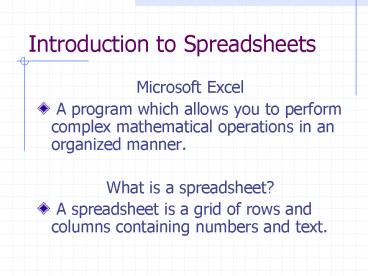Introduction to Spreadsheets - PowerPoint PPT Presentation
Title:
Introduction to Spreadsheets
Description:
Introduction to Spreadsheets Microsoft Excel A program which allows you to perform complex mathematical operations in an organized manner. What is a spreadsheet? – PowerPoint PPT presentation
Number of Views:295
Avg rating:3.0/5.0
Title: Introduction to Spreadsheets
1
Introduction to Spreadsheets
- Microsoft Excel
- A program which allows you to perform complex
mathematical operations in an organized manner. - What is a spreadsheet?
- A spreadsheet is a grid of rows and columns
containing numbers and text.
2
Terms you need to know
- Rows
- Columns
- Range
- Cells
- Active Cell
- Cell Address
- Workbook
- Worksheet
- Labels
- Numeric Labels
- Values
- Mathematical Operators
- Orders of Operation
- Equation Formula
- Function Formula
3
Some Terms
- Workbook
- - An excel file that contains single or multiple
worksheets.
- Worksheet
- - One page in an Excel workbook
4
Rows vs. Columns
- Rows
- -Identified by 1,2,3, etc. and goes across the
spreadsheet horizontally
- Columns
- -Identified by A,B,C and goes across the
spreadsheet vertically.
5
The Size of the Spreadsheet
- Number of Rows
- - 65536
- Number of Columns
- - 256
6
Cell
- This is where a row and column meet. Each cell
has a cell location. Examples of this are A1,
C5, Z34. - Label-alphanumeric data that describes the values
that follow and cannot be used in a calculation. - Value-Numeric data that can be used in
calculations. - Range-A rectangular group of adjacent cells.
7
Columns
R O W s
Active Cell
Range
Range
8
Edit Cell
Cell Address
Label
Numeric Label
9
Numeric Label
Label
Value
10
Mathematical Operators
- Addition
- Subtraction
- Multiplication
- Division /
X -
11
Orders of Operation
- Parenthesis
- Exponents
- Multiplication
- Division
- Addition
- Subtraction
12
Two Types of Formulas
- A formula in an instruction to calculate a
number. - All formulas begin with an equal sign
- Equation Formulas
- Use mathematical operators
- Function Formulas
- Use function names (no math operators)
13
Equation Formulas
To add cellcellcell To subtract cell-cell
To multiply cellcell To divide cell/cell
Or any combination of math operators Example
A110 Example (A1B3)B710
A1 10 B3 2 B7 5
14
Function Formulas
- function name (cellcell)
- Function Names
- SUM adds a range of cells
- AVERAGE finds the average of a range of cells
- MIN lowest value in a range
- MAX highest value in a range
- COUNT number of cells filled with a value
- COUNTA number of cells filled with a label
15
Function Formulas
- The first step to using formulas is to think
about what mathematical operation you want to
accomplish. It helps sometimes to write the math
problem on paper first. - Next click on the cell where you want the answer
to the formula to appear. - Choose the formula you want from the drop down
menu next to the SUM icon. - Select the cells you want to include in the
operation. - If EXCEL guesses the cells for you, MAKE SURE TO
VERIFY THAT THOSE ARE THE CELLS YOU WANT! EXCEL
IS NOT ALWAYS RIGHT!!
16
Formulas and Functions
- Formulas always begin with the sign. This
symbol tells Excel that a calculation is
required. Formulas do not include spaces, and
can include values and/or references to other
cells.
17
Formulas
- To Add cellcellcell or sum(Range)
- To Subtract cell-cell
- To Multiply cellcell
- To Divide cell/cell
- To Average average(range)
- Lowest min(range)
- Highest max(range)
- Counts count(range)
- Count Labels counta(range)
- Conditional Statement if(condition, then x,
else y)
18
Checklist (for each spreadsheet)
- Headings Centered Over Columns
- Title Centered over the Spreadsheet
- Correct Formulas
- Decimals aligned in numeric columns
- Commas and Dollar Signs where appropriate
- Centered Vertically and Horizontally on page
- Name, Period, and Name of Spreadsheet in the
Header

